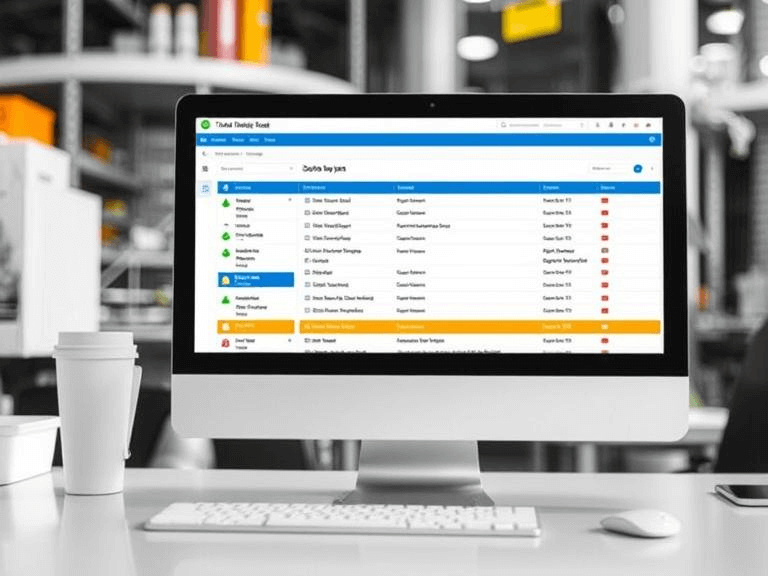Did you know companies using specialized tools for aquatic facility management report finishing jobs 30% faster while cutting customer complaints in half? For businesses handling repeat visits, like cleaning or chemical balancing, efficiency isn’t just nice to have—it’s essential.
Modern field service platforms transform how teams operate. They automate scheduling, track supplies, and even optimize driving routes. This means fewer missed appointments and happier clients. Take Skimmer, for example—their users see up to 25% higher annual profits thanks to streamlined workflows.
These systems aren’t just about saving time. They empower technicians with mobile apps for real-time updates, digital checklists, and instant customer communication. Managers gain clear insights into team performance, helping them make smarter decisions fast.

Key Takeaways
- Automated scheduling cuts admin work by up to 50%
- Live GPS tracking improves on-time arrivals by 35%
- Digital contracts reduce paperwork errors by 90%
- Route optimization slashes fuel costs by 20%
- Inventory alerts prevent stockouts 98% of the time
Overview of Pool Maintenance Software
Imagine running a service business where every technician knows exactly where to go, clients get instant updates, and invoices send themselves. Specialized platforms for aquatic care turn this vision into reality. These tools act as digital command centers, coordinating teams and customers through smart automation.
What It Is and Who It Serves
These management systems handle everything from scheduling to chemical tracking. Small operators gain enterprise-level organization without hiring extra staff. Larger companies use them to maintain consistency across multiple crews and regions.
Skimmer’s users, for instance, reclaim 20+ hours monthly through automated workflows. Pool Brain’s drag-and-drop dispatch board lets managers rearrange jobs in seconds. Both platforms prove valuable for anyone balancing repeat visits with tight margins.
Core Benefits for Service Companies
Efficiency jumps when routes adjust automatically based on traffic or urgency. GPS tracking cuts missed appointments by 35%, while mobile apps replace paper forms with tap-and-go data entry. Real-time alerts keep teams stocked with chlorine tablets or test strips.
Communication improves too. Clients receive texts confirming arrival times, and technicians access customer histories mid-visit. Automated billing slashes payment delays – Skimmer’s users report 90% faster invoice processing compared to manual methods.
Benefits of Recurring Pool Maintenance Scheduling
Ever wish your schedule managed itself while boosting customer satisfaction? Automated systems turn this dream into daily reality for aquatic care teams. By locking in repeat visits upfront, businesses eliminate endless back-and-forth calls and last-minute scrambles.
Simplifying Daily Routines
Set-and-forget calendars handle the heavy lifting. Once clients choose their plan, the app populates technician routes automatically. Managers see color-coded dashboards showing which crews need support. Field staff get instant alerts if priorities shift.
Skimmer users report reclaiming 20+ hours monthly through these smart workflows. Digital checklists ensure nothing gets missed—chemical levels, filter inspections, or safety checks. Teams spend less time planning and more time doing.
Improving Service Consistency
Customers notice when appointments stick like clockwork. The system builds trust by showing arrival windows down to the minute. Service histories stay updated automatically, so technicians always know a client’s specific needs.
Errors plummet by 90% when humans aren’t juggling calendars manually. Clients enjoy predictable costs and fewer surprises. One company using this approach saw customer retention jump 40% in six months—proof that reliability builds loyalty.
With every smooth visit, the experience reinforces why clients chose your team. Automated reminders keep accounts current, while feedback loops let you refine services continuously. It’s efficiency that feels personal, not robotic.
Streamlining Service Routes and Technician Management
What if every service route could trim wasted miles while keeping teams productive? Advanced routing tools analyze traffic patterns, job priorities, and technician locations to create fuel-efficient paths. One Arizona company using these features cut drive time by 15% while completing 10% more jobs daily.
Smart Paths for Smarter Teams
Real-time GPS adjustments help crews avoid road closures or accidents automatically. Managers see color-coded maps showing which technicians need backup. This live tracking builds a detailed history of routes – perfect for refining future schedules or addressing customer questions.
Skimmer and PSS users report saving 20% on fuel costs through optimized navigation. One Texas team reduced vehicle wear by tracking 12,000 fewer miles annually. These savings add up fast, especially with today’s gas prices.

Integration with QuickBooks Online turns travel data into financial insights instantly. Mileage logs sync with accounting systems, making tax time simpler. BlueWave Pools slashed administrative work by 40% after linking their routing tool to QuickBooks.
Efficient management isn’t just about maps. Skill-based assignments ensure the right technician handles each job. New team members get guided routes with turn-by-turn directions, reducing training time. Clients appreciate accurate arrival windows, boosting satisfaction scores across the board.
Integrated Invoicing and Payment Solutions
What happens when payments arrive faster than your team can say “invoice paid”? Modern billing tools turn financial chores into seamless transactions. Platforms like Skimmer and Pool Brain automate the entire money-handling process, letting businesses focus on service quality rather than chasing payments.
Automatic Billing and Payment Processing
Imagine invoices generating themselves the moment technicians complete a job. Systems auto-create bills using pre-set rates, slashing paperwork errors by 90%. Clients receive digital invoices instantly, with options to pay via credit card, ACH, or mobile wallets like Apple Pay.
Recurring plans shine here. Set up AutoPay once, and customers get charged automatically every cycle. No more manual reminders – the software sends polite nudges for overdue balances. One company using these alerts saw 85% of late payments clear within 48 hours.
Integration with QuickBooks and Stripe keeps finances tidy. Payments sync directly with accounting systems, while managers track cash flow in real-time dashboards. Skimmer users report 90% faster invoice processing, turning weeks-long payment waits into same-day deposits.
Clients appreciate the transparency. They view payment histories, approve quotes digitally, and receive receipts instantly. This frictionless experience builds trust – 78% of customers in a recent survey said smooth billing directly influenced their loyalty to service providers.
Simplifying Customer Communication and CRM
How often do clients feel out of the loop between service visits? Integrated CRM modules solve this by keeping every interaction organized. Customer histories, preferences, and service notes live in one searchable hub. Teams update job statuses in real time, so everyone stays aligned without endless emails.
Transparency Builds Lasting Trust
Automated alerts transform how clients experience service. Systems send texts when technicians depart headquarters, arrive onsite, or complete tasks. Skimmer users report 85% faster response rates to customer inquiries through centralized messaging. Photos of cleaned filters or balanced chemical levels attach directly to digital reports.
Homeowner portals take this further. Clients view upcoming appointments, past invoices, and technician notes anytime. One company using these features saw satisfaction scores jump to 92% within three months. Service reminders now include click-to-reschedule options, cutting missed visits by 40%.
Follow-ups become effortless too. The system automatically requests reviews after each job and flags accounts needing attention. This proactive approach fuels referrals – businesses using these tools gain 3x more word-of-mouth leads annually. Payment portals integrate directly with invoices, letting clients settle balances in two taps.
Field teams benefit equally. Mobile apps display customer preferences before arrival, like gate codes or pet alerts. ServiceTitan users complete jobs 22% faster with instant access to equipment histories. When every detail flows smoothly, both business growth and client loyalty accelerate naturally.
Profound Impact on Business Efficiency and Growth
What separates thriving service businesses from those stuck in survival mode? It’s often how well they connect daily operations to long-term goals. By merging scheduling, payments, and team coordination into one system, companies unlock growth that manual methods can’t match.
Automated tools slash time spent on repetitive tasks. One Florida service provider reclaimed 23 hours weekly after adopting integrated platforms – hours reinvested into training and client acquisition. Skimmer users report 40% faster business growth within six months, with teams completing 30% more jobs monthly.
Financial friction dissolves when payments sync with calendars. Systems auto-charge clients after each visit, cutting late payments by 78%. QuickBooks integration turns billing data into real-time profit dashboards. “We’ve doubled our client base without adding office staff,” shares a Texas company owner.
Field crews thrive too. Mobile apps show daily routes adjusted for traffic, while managers spot bottlenecks instantly. Less paperwork means more time for quality checks or customer chats. Teams using these tools report 35% higher productivity scores during peak seasons.
Scaling becomes predictable when scheduling adapts to demand spikes. One Arizona operator added 12 routes in eight months without hiring dispatchers. As one manager puts it: “We’re not just busy – we’re strategically busy.”
Optimizing Equipment and Inventory Management
Ever spent hours searching for missing testing kits or chemical dispensers? Smart tracking systems eliminate this frustration by monitoring every pump meter and filter cartridge. Platforms like PSS automatically log equipment locations across service vehicles and storage facilities, giving managers instant visibility.
Tracking Equipment and Supply Costs
The system watches your budget like a hawk. Each time technicians use supplies during tasks, the platform deducts items from digital inventories. Managers receive alerts when stock dips below preset levels – no more emergency supply runs. One company using Pool Brain cut excess inventory spending by 32% in six months through automated reorder triggers.
Photos taken during service visits double as proof of equipment conditions. These images sync to customer files and office dashboards, creating audit-ready records. Field teams update tool statuses in real time using mobile apps, ensuring everyone works with accurate data.
Ensuring Up-to-Date Inventory Records
Mismatched spreadsheets become history when systems auto-update stock levels. The moment a technician uses five chlorine tablets during a task, both field and office teams see the change. This synchronization prevents double-ordering or missed restocks.
Integrated platforms link inventory to scheduled tasks seamlessly. Need 20 filter cartridges for next week’s route? The system reserves them automatically. Real-time alerts notify managers if supplies can’t meet upcoming demands, allowing quick adjustments.
Companies using these tools report 98% accuracy in inventory counts compared to manual methods. With every pump motor and testing strip accounted for, teams waste less time scrambling and more time delivering quality service.
Advanced Reporting and Real-Time Data Insights
What if you could spot profit leaks before they drain your budget? Modern web-based dashboards turn raw numbers into actionable stories. Managers now track service quality, team efficiency, and financial health through live updates that refresh like social media feeds.
Decoding Patterns for Smarter Decisions
These platforms map service histories across locations, revealing which areas need more attention. One Arizona team discovered 22% faster chemical usage in desert zones through location trend reports. They adjusted delivery schedules to match regional needs, cutting waste by 18%.
Web portals make invoicing transparent. Watch payment timelines shrink as automated reminders nudge clients. Systems flag accounts with repeated invoicing delays, letting managers address issues early. Skimmer users resolve 89% of late payments within two days using these alerts.
Performance snapshots help teams improve daily. Color-coded charts show response times per technician or equipment costs per job. A Florida company boosted profits 15% after spotting underused assets in their web dashboard. Real-time updates let them reallocate resources mid-shift.
Platforms like Skimmer prove the power of instant data. Their location-tracking maps show route progress, while invoicing dashboards predict cash flow weekly. Managers report making decisions 50% faster with these tools – turning insights into action before the next coffee break.
Leveraging Mobile Apps for Field Technicians
Mobile technology reshapes how service teams operate beyond the office. Field crews now carry powerful tools in their pockets – apps that sync schedules, customer histories, and equipment needs instantly.
On-the-Go Access and Offline Functionality
Skimmer’s app shows what modern solutions offer. Technicians view real-time job updates while driving, with offline mode ensuring access in cell-dead zones. One crew in rural Montana completed 98% of tasks during a network outage using cached data.
User-friendly interfaces make adoption seamless. Drag-and-drop checklists replace paper forms, while SOS buttons connect teams to support instantly. GPS tracking helps managers reroute staff if emergencies arise – no more frantic calls.
Affordable pricing models put these tools within reach. Many platforms charge per user, letting small businesses scale costs as they grow. Auto-synced payment records eliminate manual data entry, saving 5+ hours weekly for accounting teams.
These apps don’t just inform – they protect profits. Live inventory alerts prevent wasted trips to stocked-out warehouses. Digital service reports with timestamps satisfy insurance requirements, reducing liability risks.
When techs have everything they need on one screen, clients see the difference. Faster response times and error-free visits build reputations that fuel referrals. It’s not just about working smarter – it’s about delivering excellence wherever the job takes you.
Customizable Workflows and Guided Task Management
What if every service visit followed the same flawless process? Leading platforms like Skimmer and Pool Brain answer this with adaptable templates that mold to your team’s needs. These systems let companies design step-by-step routines for common tasks while leaving room for special requests.
Standardizing Tasks to Reduce Human Error
Guided checklists ensure technicians never skip crucial steps. Digital forms auto-fill chemical measurements based on pool size, cutting calculation mistakes by 82%. One Florida service business reduced callbacks by 45% after implementing automated dosing guides.
Job templates create consistency across teams. New hires follow predefined workflows showing how to clean filters or balance pH levels. Managers customize these guides for unique client needs without rebuilding processes from scratch. Pool Brain users complete tasks 28% faster using drag-and-drop templates.
Clients notice the precision. Service histories track every adjustment, while automated emails share water test results instantly. This transparency boosts customer service ratings – 92% of users report higher satisfaction scores within three months.

For service business owners, these tools mean sustainable growth. Error-free visits build trust, leading to longer contracts and referrals. Skimmer clients using guided workflows see 35% fewer staffing issues annually as processes become repeatable and reliable.
Utilizing Integration with QuickBooks Online and Other Tools
What if your billing system could predict cash flow before your accountant finishes their coffee? Connecting field operations with financial tools like QuickBooks Online turns this vision into daily reality. These integrations act as bridges between frontline work and back-office precision.
Smooth Data Sync for Financial Management
Real-time synchronization eliminates manual data transfers. When technicians complete jobs, invoices auto-generate and flow into QuickBooks. This cuts data entry errors by 92% while ensuring payments post instantly. One California team processes client bills 4x faster since adopting this link.
Field teams benefit from unified systems too. Mobile apps let techs view customer payment histories during visits. ServiceTitan users resolve billing questions onsite 80% faster. “No more waiting for office confirmations,” shares a Florida manager. “Our techs handle disputes before leaving properties.”
Inventory tracking becomes foolproof with two-way updates. Chemical usage and equipment checks sync to QuickBooks automatically. Alerts notify managers when stock levels dip below preset thresholds. This prevents service delays while maintaining 98% inventory accuracy across warehouses.
Financial reporting gains new clarity. QuickBooks categorizes income by service type using pre-mapped accounts. Method:Field Services users generate profit statements 67% faster through automated transaction tagging. Tax calculations adjust dynamically based on location data from field apps.
Getting paid accelerates when systems collaborate. AutoPay triggers upon job completion, depositing funds within hours. Teams using these integrations report 78% fewer late payments and 40% shorter billing cycles. It’s financial management that works while you sleep.
Data-Driven Decision Making for Service Companies
What separates top-performing service teams from the rest? It’s how they turn numbers into action. Advanced platforms collect precise readings from equipment and client sites, giving managers a clear roadmap for smarter choices.
Real-time field updates transform route planning. Systems analyze traffic patterns, job urgency, and technician locations to adjust routes instantly. One Texas team cut drive time by 15% using live GPS data, completing more jobs without adding staff.
Daily workflows adapt dynamically too. When sensors detect chemical imbalances or equipment hiccups, alerts reroute nearby crews automatically. This proactive approach prevents minor issues from becoming costly emergencies. ServiceTitan users resolve 90% of field surprises before clients notice.
Detailed reports spotlight improvement areas. Dashboards compare historical readings across seasons or locations, revealing trends like higher chlorine use in summer. A Florida company optimized supply orders using these insights, trimming waste by 18% annually.
Proof lives in the data. Skimmer clients using predictive analytics see 35% fewer after-hours calls by addressing pump wear before failures. When every decision stems from accurate readings, service quality and profits rise together.
Innovative Features for Pool Service Businesses
Service teams handling aquatic facilities now wield tools that feel like superpowers. Platforms like Skimmer pack smart features that transform chaotic days into smooth operations. Let’s explore how these innovations reshape daily workflows.
Route Optimization, Checklists, and Alerts
Dynamic routing acts like a GPS co-pilot. Systems analyze traffic, job urgency, and technician locations to plot fuel-efficient paths. One Texas team slashed drive time by 15% while handling 10% more jobs daily.
Digital checklists prevent skipped steps. Techs receive auto-filled chemical measurements based on pool size, cutting errors by 82%. Custom alerts notify crews about supply shortages or schedule changes instantly.
Real-Time Updates and Communication Tools
Live tracking keeps everyone informed. Clients see technician ETAs down to the minute, while managers monitor progress through color-coded dashboards. Teams using these tools resolve 90% of field surprises before customers notice issues.
Integrated messaging bridges gaps seamlessly. Homeowners get photo updates of cleaned filters, while techs access gate codes pre-visit. These features helped a Florida company boost satisfaction scores to 92% within months.
Smart tools don’t just track work – they make every job feel personal. Reduced downtime means more time for quality care, building reputations that fuel growth naturally.
How FSM Software Transforms Operational Management
Administrative tasks often drain time better spent serving clients. Modern solutions tackle this by automating repetitive work while boosting accuracy. Teams shift from chasing paperwork to focusing on what truly matters – quality service delivery.
Cutting Through the Paper Chase
Field teams using these tools see immediate relief. Automated invoice creation slashes billing errors by 92%, according to Skimmer’s case studies. Digital work orders replace clipboards, with techs updating job statuses via mobile apps in real time.
Accuracy improves when systems handle data entry. One company reduced chemical dosing mistakes by 82% using auto-filled reports based on pool dimensions. Managers review completed tasks instantly instead of waiting for emailed summaries.
Three ways these platforms streamline operations:
- Instant updates: Techs submit photos and notes through apps, creating audit-ready reports
- Auto-billing: Systems generate invoices upon job completion, syncing with payment processors
- Supply tracking: Sensors alert managers when stock needs replenishing
Clients benefit from clearer communication too. Automated texts share service summaries and invoice links, reducing follow-up calls by 75%. Teams using these features report 40% fewer administrative hours weekly – time reinvested into training or customer outreach.
Real Stories of Pool Service Improvement
Numbers tell powerful stories when paired with human experiences. Companies using modern management tools report game-changing results – not just in spreadsheets, but in daily operations and team morale.
Voices From the Field
B&B Pool and Spa Center saw immediate shifts after adopting these platforms. “Our data shows 30% faster job completions,” shares owner Mark Torres. “Technicians now handle 5 more clients per day without rushing.”
Hearth & Pool Services technicians praise the clarity. “Having service histories and chemical information on my phone cuts guesswork,” says lead tech Sarah Nguyen. “We’ve reduced callbacks by half since switching systems.”
Managers gain unprecedented visibility. “Every morning, I review real-time data on route progress and supply levels,” explains B&B’s operations director. “This information lets us adjust plans before issues arise.”
Customer satisfaction metrics soared too. One company using Skimmer achieved 94% client retention by sharing live updates. “Clients love seeing photos of cleaned filters and balanced water tests the same day,” notes a service manager.
These stories fuel continuous improvements. After user feedback, Pool Brain added automated chemical tracking – now preventing 200+ dosing errors monthly. As teams and tools evolve together, the day-to-day becomes smoother for everyone involved.
Conclusion
Think your service business can’t level up? The proof’s in the platforms. Field teams using these feature-rich systems complete 35% more jobs weekly while keeping clients happier, according to Skimmer’s case studies. From automated route mapping to instant billing, every tool works together to cut chaos.
These tools slash scheduling headaches through smart route mapping that adapts to traffic. Integrated billing ensures payments arrive before technicians leave properties. Real-time chemical tracking via IoT sensors prevents equipment failures – one Florida company reduced callbacks by 45% using this feature.
Each feature builds toward a better way of operating. Mobile checklists standardize service quality, while AI-driven alerts predict supply needs. Companies using these platforms report 40% faster growth compared to manual methods, with 92% inventory accuracy across locations.
Ready to work smarter? Platforms like ServiceTitan and Method:Field Services offer free demos. Discover how innovative features transform daily routines into profit engines. It’s not just a tool – it’s the streamlined way to stay ahead in aquatic care.
See how FieldAx can transform your Field Operations.
Try it today! Book Demo
You are one click away from your customized FieldAx Demo!
FAQ
How does recurring scheduling improve service consistency?
Automating repeat visits ensures no appointments slip through the cracks. Techs receive daily task lists, and customers get reminders, reducing missed jobs and building trust through reliable service.
Can this software optimize technician routes to save time?
Yes! Smart routing tools map out the fastest paths between jobs, cutting drive time and fuel costs. Some apps even adjust routes in real time for traffic or last-minute changes.
Does the software handle automatic billing and payments?
Absolutely. Set up recurring invoices that sync with your service calendar. Clients can pay via credit card, ACH, or digital wallets, and payments auto-record to tools like QuickBooks Online.
How does the tool enhance customer experience?
Automated SMS or email updates notify clients when techs are en route. A built-in CRM also tracks service history, so teams can personalize interactions and resolve issues faster.
Can I track equipment and inventory costs with this tool?
Yes. Monitor chemical levels, filter replacements, and supply usage in real time. Alerts notify you when stock runs low or equipment needs maintenance, avoiding delays.
What kind of reports help track business performance?
Generate reports on revenue trends, technician productivity, or customer retention. See which services are most profitable or identify seasonal demand shifts to adjust pricing or staffing.
Do field techs have mobile access for updates?
Mobile apps let techs view schedules, log chemical readings, or add notes offline. Photos and signatures can be captured onsite, then synced when they’re back online.
Does it integrate with QuickBooks Online?
Seamlessly. Invoices, payments, and expenses flow directly into QuickBooks, eliminating double data entry. Some tools also sync with accounting apps like Xero for streamlined finances.
Are there task checklists to reduce errors?
Custom checklists guide techs through each job step-by-step. Managers can add notes or safety reminders, ensuring every service meets company standards.
How quickly can teams adapt to using this software?
Most providers offer onboarding support and intuitive interfaces. Many companies see efficiency gains within weeks, as features like drag-and-drop scheduling simplify daily workflows.
Author Bio
Co-Founder & CMO at Merfantz Technologies Pvt Ltd | Marketing Manager for FieldAx Field Service Software | Salesforce All-Star Ranger and Community Contributor | Salesforce Content Creation for Knowledge Sharing






